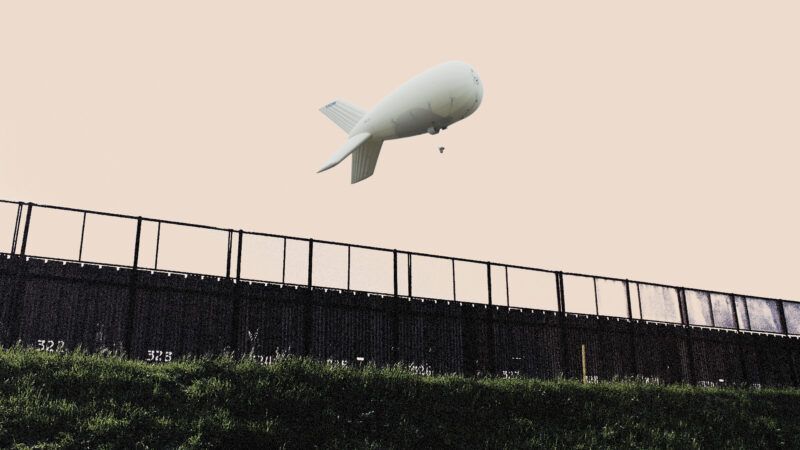Border Patrol Launched a Surveillance Blimp Over Nogales, Arizona. Town Officials Didn't Know.
Residents of Nogales are now under the gaze of a round-the-clock surveillance craft.

Last week, residents of Nogales, Arizona—a border-hugging town of about 20,000 people—awoke to find a large white blimp stationed in the sky. Even elected officials had no idea the blimp was coming. "What the hell?" Mayor Arturo Garino told Nogales International. "Did it land here by mistake?"
The blimp, it turns out, is conducting around-the-clock surveillance on behalf of U.S. Customs and Border Patrol (CBP), which launched the craft last Thursday. The CBP issued a press release on the project just one day prior, noting that the blimp would be "operational and manned by Border Patrol Agents 24 hours a day, seven days a week, to provide continuous aerial surveillance of the border." By the time the official CBP announcement came out, some Nogales residents had already noticed the blimp beginning to be inflated.
Many residents and local officials are concerned about the lack of advance warning, not to mention the harmful effects the blimp might have on people's privacy.
"The blimp is the Border Patrol," says Edward Dickie, city manager of Nogales. It "has nothing to do with the city at all. In fact, we weren't aware that they were going to put it up."
The blimp's staging area is stationed on a hill near Nogales' East Patagonia Highway, just a quarter-mile from a residential neighborhood. Tethered approximately one mile away from the U.S.-Mexico border, residents under the blimp's gaze have questions about the craft's activities. "I don't know what they're surveilling," Rafael Lopez, who lives roughly a half-mile from where the blimp is floating, told Nogales International. "I don't know what type of instruments they have on there and what they can see."
Federal immigration authorities have been mum about what the blimp is watching. They have offered a vague reference to "border activity," and they later stated the craft would not be oriented toward activities "outside the immediate areas of the border." With the ability to provide surveillance both night and day, and a maximum range of 3,000 feet above the ground, the blimp is certainly capable of snooping on many people.
"I think it's evidence of a kind of growing police state along the border," Santa Cruz County Sheriff David Hathaway told Nogales International. "It just seems weird and dystopian to have that kind of surveillance platform right in the middle of the city."
The office of Rep. Raúl Grijalva (D–Ariz.), whose district includes Nogales, declared in an emailed statement that we "urgently need transparency and oversight with these invasive border surveillance technologies."
Nogales is already heavily monitored, with a combination of local, state, and federal authorities active on the ground. Local officials questioned how the blimp would benefit those existing efforts, given that it's stationed over the already heavily surveilled highway area rather than a remote stretch of town. Other critics, such as Grijalva, cite research that indicates the expansion of border surveillance technologies has been accompanied by an increased death rate among migrants crossing the border. Three Tucson-based researchers have noted that increased surveillance "simply shifted migration routes into much more difficult and remote terrain."
There are now 17 blimps stationed over the U.S.-Mexico border. The Nogales blimp is the first in eastern Arizona, though the CBP tentatively plans to launch another in that sector later this year.


Show Comments (57)